Inter-carrier Interference Analysis for MIMO-OFDM Systems in High-Speed Train Environment
WANG Jun-hua (王军华),JIAO Wu-chen (焦戊臣),FANG Yong (方 勇)
School of Communication &Information Engineering,Shanghai University,Shanghai 200444,China
Introduction
High-speed train (HST) is a kind of fast orbit transportation tools,and the speed is more than 200 km/h.The communication model of HST is the broadband wireless communication.With the rapid development of HST worldwide,security,convenience and operational efficiency of passenger information services in the HST scenario have been ever-increasing.Moreover,a lot of key technical requirements have been imposed to the systems design of broadband wireless communications.
As a promising technique to meet those requirements,orthogonal frenquency division multiplexing (OFDM)has been widely recognized as the key physical layer technology for the next generation broadband wireless communications[1].OFDM divides the broadband into many narrow bands for each subcarrier,which has the robustness to the frequency-selective fading multipath channel.Moreover, OFDM presents advantages of high spectrum efficiency,mitigating inter-symbol interference (ISI)by inserting a cyclic prefix (CP).OFDM has become a standard technique for the third-generation partnership project long-term evolution (3GPP LTE)[2]and worldwide interoperability for microwave access (WiMAX)[3]standards.Apart from several advantages,multi-carrier OFDM systems also have some drawbacks.The main drawback is that OFDM requires strict orthogonality between subcarriers.The orthogonality between the subcarriers is destroyed due to the Doppler frequency offset,particularly in the HST environment,which leads to serious ICI,and system performance may be considerably degraded.Therefore,it is necessary and significant to investigate the mechanism and influence factors of ICI.
There is a large number of literatures about ICI of OFDM systems,but not a lot for HST environment,because the features of HST channel deviate significantly from those in low mobility.The channel of HST is non-stationary because the traversed environments are vary and complex,while the models of existing literatures are almost stationary.Based on the feature of wide sense stationary uncorrelated scattering (WSSUS),Zheng and Wang[4]analyzed the ICI of fractional Fourier transform orthogonal frequency division multiplexing (FRFT-OFDM)systems and discrete Fourier transform OFDM (DFT-OFDM)systems by evaluating the influence of ICI by utilizing the expressions of signal-to-interference ratio (SIR).Wang et al.[5]analyzed the ICI energy based on Jakes's model and gained the conclusion that most of a symbol energy spread over itself and its neighborhood subcarriers for the normalized Doppler frequency offset was small,and Cai and Giannakis[6]also achieved the conclusion for the continuous signal model.Ma et al.[7]explored the channel and interference gains for OFDM subchannel and gave a fact that the ICI was caused by the time-varying channel within one OFDM symbol.Haque et al.[8]analyzed the ICI of aeronautical channel.Assume that the model characteristics are known and the change of channel is relatively slow to an OFDM symbol.Basing on the linear time-varying channel model,Lin et al.[9]analyzed the effect of ICI and proposed a time domain ICI self-cancellation method.Du et al.[10]presented and compensated the ICI by estimating the high doppler shifts in long-term evolution for railway (LTE-R)systems.Shi[11]summarized the ICI problem and proposed the method to mitigate ICI in high mobility.Wang et al.[12]analyzed and explored the correlation property of ICI in the fast channel variation arising from highspeed motion.Chen et al.[13]explored the ICI vector in multipleinput multiple-output (MIMO)-OFDM systems and expressed the ICI gains at a particular subcarrier for channels with ITU-R vehicular channel A (VA)profile.For doubly-selective fading channels,Shu et al.[14]analyzed and deduced the upper bound of ICI power.Based on the additive white Gaussian noise(AWGN)channel,ICI is analyzed[15].The conventional channels of above literatures are WSSUS Rayleigh fading channel,flat fading channel and AWGN channel,which can't be used in HST environment.At present,the communication quality of HST is quite poor and a low data rate is observed[16].Some measurements and models about HST channel are implemented.Liu et al.[17]achieved the related parameter characteristics of HST channel by practical measurements.Gao et al.[18]estimated Ricean factor K by using a moment-based estimator along the Zhengzhou-Xi'an high speed railway.Gesbert et al.[19]presented a new model for MIMO outdoor wireless fading channels and investigated their capacity performance.Ghazal et al.[20]proposed a non-stationary geometry-based stochastic model(GBSM)in continuous domain for MIMO HST channels.Cheng et al.[21]proposed an adaptive GBSM for non-isotropic MIMO mobile-to-mobile (M2M)Ricean fading channels.For the geometrical street model,Chelli et al.[22]derived a nonstationary MIMO vehicle-to-vehicle (V2V)channel model.However,these measurements and models only analyze the channel of HST,there are no joint OFDM systems or MIMOOFDM systems to analyze and test the channel.Therefore,it is crucial to establish an HST channel model and joint MIMOOFDM systems to analyze and test the communication quality of the HST channel.The purpose of this paper is to get this target.
The rest of this paper is organized as follows.Section 1 describes the system model including discrete channel model and MIMO-OFDM systems model.The CIR and channel coefficients are analyzed in section 2.The simulation results are discussed in section 3 and conclusions are drawn in section 4.
1 System Model
1.1 Discrete channel model
For most of wireless channels,there is more than one path from transmitter to receiver.It occurs multiple paths due to reflection,scattering and refraction from different objects.We consider a high speed railway channel model which is different from traditional channel model.It has a big Doppler frequency offset because of high speed,angles of departure (AoD)and angles of arrival (AoA)are time-variant,which make the HST channel have the character of non-stationary.Ghazal et al.[20]proposed a non-stationary GBSM in continuous domain for MIMO HST channels.We will achieve a discrete HST channel model based on the GBSM for MIMO-OFDM systems.
In order to achieve discrete-time channel impulse response,we must determine how to sample the channel of GBSM.Let W'be the baseband input signal bandwidth and BDbe the bandwidth of the maximum Doppler spread,then the bandwidth W =W' +BDand the range of bandwidth is set to[-W/2,W/2].If we set the sampling interval ts= 1/W,the Nyquist sampling is achieved.A detailed argument about the sampling rate required for time-varying channels can be found in Médard's literature[23].Therefore,the sampling interval is ts=1/(W' +BD).Ghazal et al.[20]proposed GBSM,and the model was consisted of multiple confocal ellipses with single-bounced (SB)rays and the line-ofsight (LoS)component[24].Considering a tapped delay line(TDL)structure,these confocal ellipses represent the taps.The base station (BS)and train are located at the foci.Then S effective scatterers are distributed on the l th ellipse,where l=1,2,…,L and L is the total number of ellipses or taps.We use the GBSM and consider an MIMO HST communication system with MTtransmitting and MRreceiving omni-directional antenna elements which are at equivalent height.The Tp-Rqlink stands for from the pth (p =1,2,…,MT)element of the BS,Tpto the qth (q =1,2,…,MR)element of the HST,Rq.The Tp-Rqlink is consisted of two parts:the first part is the first path which is a superposition of the LoS component and SB components;the second part is the other paths which are a sum of SB components only.Let t=nts(n=0,1,2,…)and based on the GBSM[20],the time-variant LoS AoA(n)[25]and time-variant scatters AoAis the AoA between link s(nl)-HST and HST direction,where s(nl)is the nlth effective scatterer at the lth ellipse,nl=1,2,…,S)in the GBSM can be described as
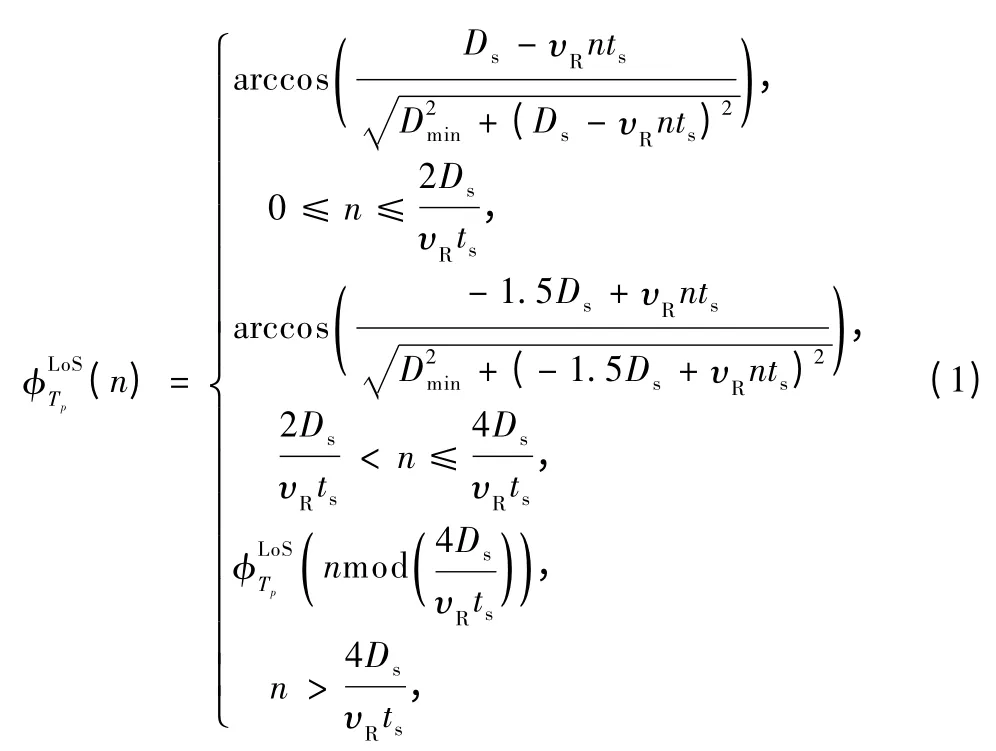
where Dsis the initial distance between BS and HST,Dminis the position of BS to the track-side,and υRis the speed of HST.

where rRis the direction of HST motion,(0)is the initial distance between scatterer s(nl)and HST,and(0)is the initial AoA.In fact, the AoDand AoAare interdependent for SB rays.The relationship between the AoD and AoA for multiple confocal ellipses model can be expressed as[21]
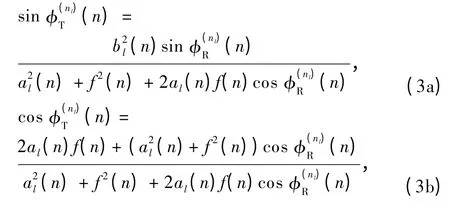
where al(n)=| al(0)- υRnts| is the semi-major axis of the lth ellipse,f(n)=| f(0)- υRnts| is the half of the distance between two focal points of ellipses,and bl(n)denotes the semi-minor axis of the lth ellipse and is defined as bl(n)=The εpq(n),εpnl(n)and εnlq(n)are the propagation distances of the waves through the links Tp-Rq,Tp-s(nl)and s(nl)- Rq,respectively.They can be described as follows,

where kp= (MT-2p +1)/2,kq= (MR-2q +1)/2;=(n)/[al(n)+f(n)cosf2(n) + 2al(n)f(n)cos(n)]/[al(n) + f(n)cos)(n)];δTand δRare the antenna element spaces at the BS and HST;and βT,βRare the multi-element antenna tilt angles.Then the propagation time of the waves through the links Tp-Rqand Tp-s(nl)-Rqcan be expressed as τpq(n)= εpq(n)/c and τpq,nl(n)=(εpnl(n)+εnlq(n))/c,(1≤l≤L),respectively.The c is the velocity of light.Then the complex channel coefficients of link Tp-Rqcan be described as follow.The first path can be expressed as

The other paths can be expressed as

Here,
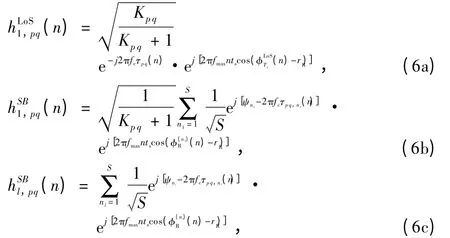
fcis the carrier frequency,Kpqis the Ricean factor,the phases ψn1and ψnlare independent and identically distributed random variables with uniform distributions over[-π,π),and fmaxis the maximum Doppler frequency offset.
Through the above description,we have achieved the discrete channel impulse response hl,pq(n).Let hp,q(n,l):=hl,pq(n),(1 ≤l ≤L),and hp,q(n,l)represents the lth channel tap at time n between the pth transmitting antenna and the qth receiving antenna.We will use the discrete channel impulse response hp,q(n,l)in MIMO-OFDM systems.
1.2 MIMO-OFDM systems model
We consider MIMO-OFDM systems with MTtransmitting antennas and MRreceiving antennas.One OFDM block contains N subcarriers.Xp(k),(0≤k≤N -1)denotes the data signal sent by the transmitting antenna p at the subcarrier k,and the power of all the data signals are equal to each other.Then the transmitted signal xp(n)in the time domain through IFFT is given by

CP is inserted into each OFDM block and transmitted signal xp(n)through the discrete non-stationary GBSM channel to the receiver.When CP is removed,the received signal of the qth antenna at time n can be expressed in the following tappeddelay-line model[26].

where l is the number of multipath,hp,q(n,l)represents the lth channel tap at time n between the pth transmitting antenna and the qth receiving antenna,and wq(n)is the AWGN with zero mean and variance σ2w.
Performing the FFT on the received signal,the signal of the qth antenna at the kth subcarrier can be expressed as


Let Gp,q(k,k)=then Yq(k)can be rewritten as

We can gain the expression from Eq.(11)thatk)·Xp(k) is the desired term, and the expression of(m,k)·Xp(m)is the ICI term.ICI term will be analyzed in section 2.
2 ICI Analysis
In order to analyze the ICI on one subcarrier (such as let the kth subcarrier be the desired subcarrier),the carrier-tointerference power ratio (CIR)can be used to evaluate the system ICI power level.The expression of CIR is the ratio of the desired received signal power on the kth subcarrier and the ICI received signal power on the other subcarriers.The expression of·Xp(k)is the desired term and the expression ofXp(m)is the ICI term for the qth receiving antenna.The additive noise is omitted.The desired signal power of the qth receiving antenna at the kth subcarrier can be represented as

The ICI power of the qth receiving antenna at the kth subcarrier is

Then the CIR of the qth receiving antenna at the kth subcarrier can be described as


where |Gp,q(k,k)| and |Gp,q(m,k)| are the amplitudes of channel coefficients between the pth transmitting antenna and the qth receiving antenna.The |Gp,q(m,k)| can be described as

where
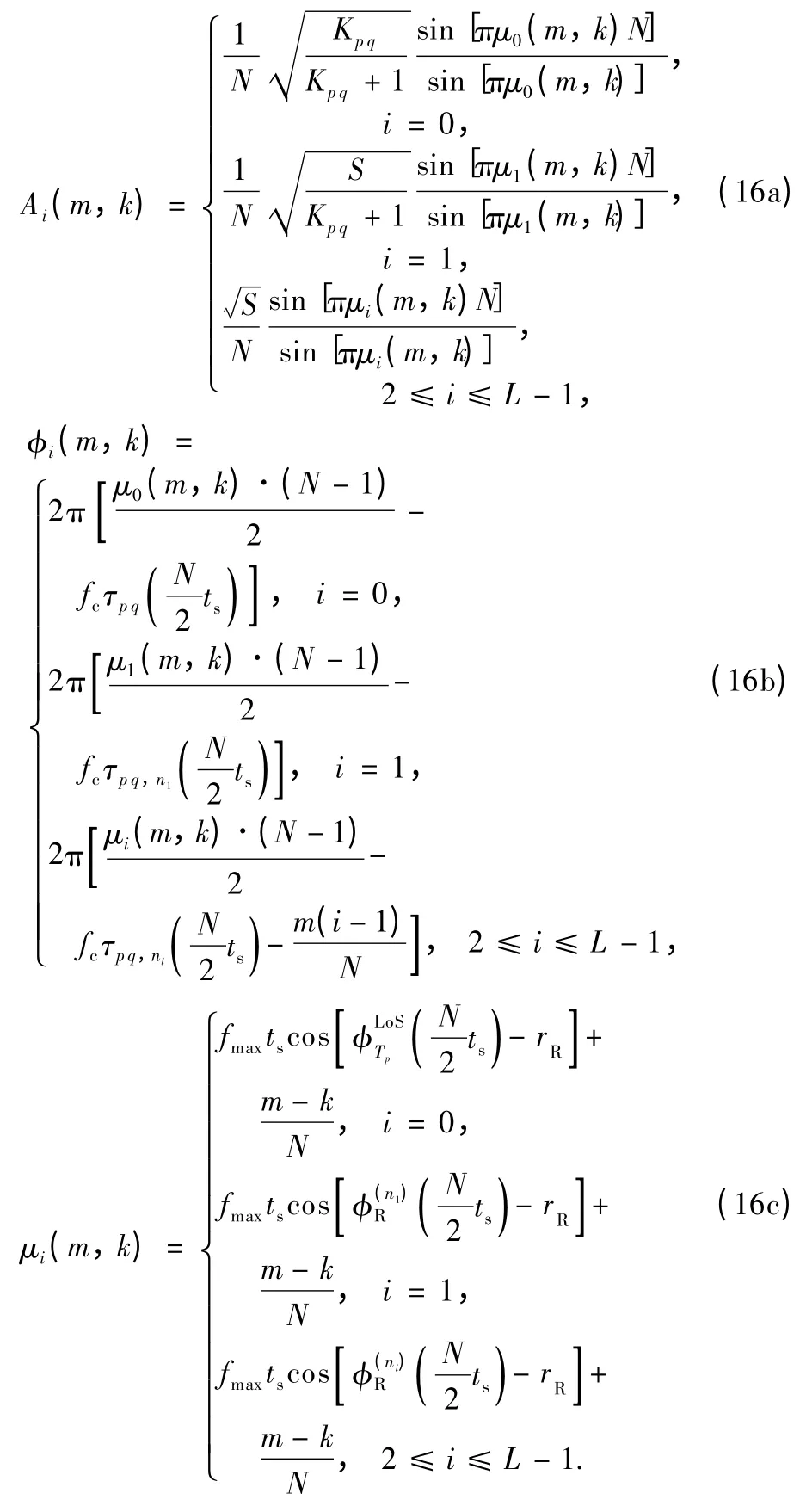
Let m=k,and |Gp,q(k,k)| can be achieved.The derivations of |Gp,q(m,k)| and |Gp,q(k,k)| are given in the appendix.
We can achieve the fact from Eqs.(13),(15),and (16)that the mainly influence factors of ICI are Kpq,the multipath number L,and the time-variant Doppler frequency offsets fd(fd=fmaxcos α,α is an angle).Therefore,we can analyze the influence of ICI via investigating the channel parameters Kpq,the multipath number L and the normalized Doppler frequency offsets ε (ε=fdNts).For Eqs.(14)and (15),we will simulate and analyze the channel coefficients | Gp,q(m,k)| and CIR by investigating Kpq,the multipath number L and the normalized Doppler frequency offset ε,respectively in section 3.
3 ICI Simulation Analysis
3.1 Channel coefficients simulation
During detecting the kth subcarrier of the pth transmitting antenna,channel coefficients |Gp,q(m,k)| are the weights of each subcarrier and determine the influence degree of the mth(m ≠k) subcarrier to the kth subcarrier.The operating frequency fcis set to 2.4 GHz,and the transmission bandwidth W' =1 MHz.Specifically,we consider a 2 ×2 MIMO-OFDM system.Figures 1-3 show the amplitudes of channel coefficients|Gp,q(m,k)| when k =32 and N =64.We obtain the fact from Figs.1-3 that most of a signal energy spreads on itself and its several neighborhood subcarriers,namely,the ICI on one subcarrier mainly comes from several neighborhood subcarriers.Figure 1 shows the amplitude of channel coefficient |Gp,q(m,k)| when K =5 dB and 10 dB.The desired signal part |Gp,q(k,k)| (k=32)for K =5 dB is less than that for K =10 dB,but the ICI signal parts |Gp,q(m,k)| almost are opposite.Figure 2 shows the | Gp,q(m,k)| with L = 2 and 6.The desired signal part |Gp,q(k,k)| (k =32)for L =2 is bigger than that for L = 6,but the ICI signal parts |Gp,q(m,k)|almost are opposite.The more number of multipaths are,the bigger interference of ICI is.Figure 3 shows the |Gp,q(m,k)|with ε=0.07 and ε=0.2.|Gp,q(k,k)| (k=32)decreases and|Gp,q(m,k)| increases as ε becomes larger.Besides,we can find from Figs.1-3 that the desired signal part |Gp,q(k,k)| is much bigger than the ICI signal part |Gp,q(m,k)|.
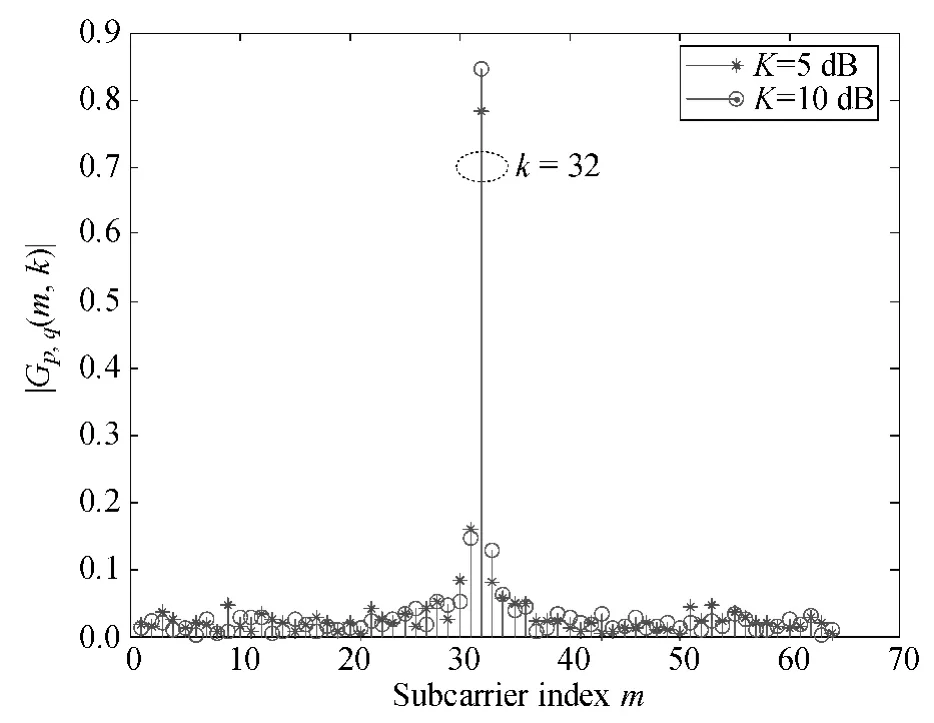
Fig.1 The change of |Gp,q(m,k)| with K,L =6,υR =500 km/h
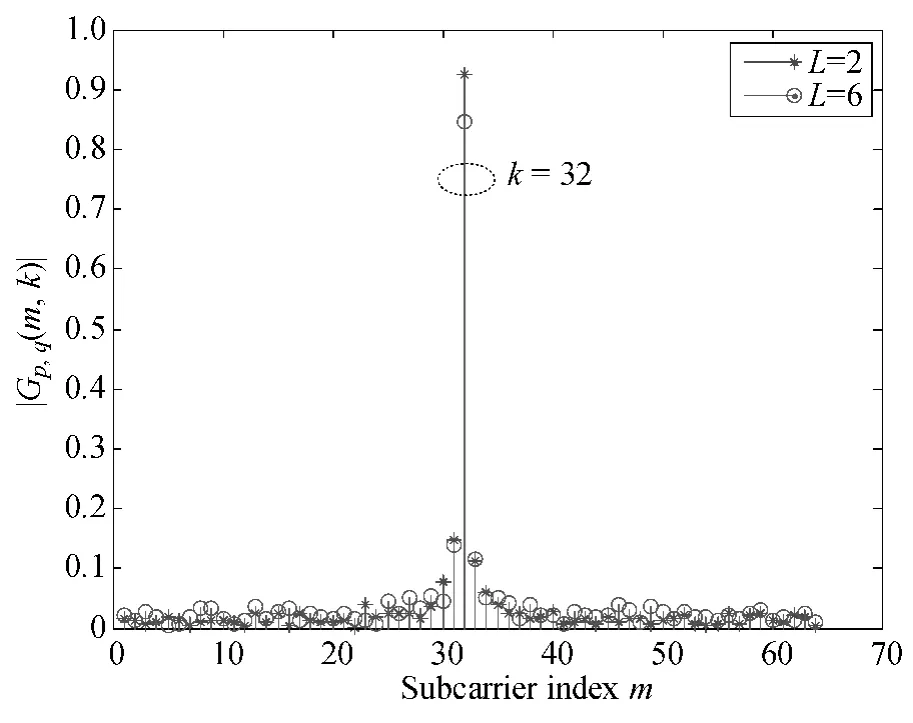
Fig.2 The change of |Gp,q(m,k)| with L,K =10 dB,υR =500 km/h
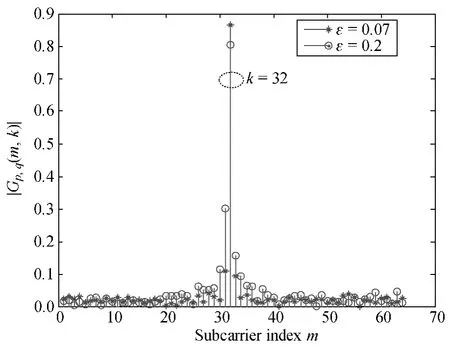
Fig.3 The change of |Gp,q(m,k)| with ε,K =10 dB,L =6
3.2 CIR and bit error rate (BER)simulations

Fig.4 The change of CIR with K,L =6,υR =500 km/h
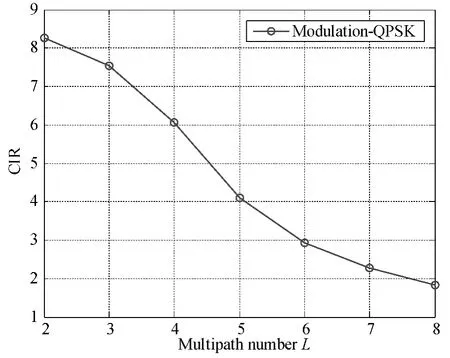
Fig.5 The change of CIR with L,K =10 dB,υR =500 km/h

Fig.6 The change of CIR with ε,K =10 dB,L =6
The CIR is used to evaluate the ICI power level.Let the desired subcarrier k=1,the total number of subcarriers N=512,the operating frequency fc= 2.4 GHz,and the transmission bandwidth W' = 1.5 MHz.Specifically,we consider a 2 × 2 MIMO-OFDM system.Figures 4-6 show the CIR as a function of K,the multipath number L and the normalized Doppler frequency offset ε,respectively.The modulation of bit source is QPSK.We can gain the fact from Figs.4-6 that CIR increases as K becomes larger,decreases as L and ε become larger,namely,the rate which ICI components power takes the total power decreases as K becomes larger,increases as L and ε become larger.Furthermore,note that the biggest impact factor for CIR is the multipath number L and the minimum impact factor for CIR is K.For Fig.5,CIR =8.2 when L =2,while CIR <1 when L =8.For Fig.4,CIR=2.0 when K =4 dB,and CIR = 3.75 when K = 20 dB.For Fig.6,the impact of normalized Doppler frequency offset ε for CIR is not significant,but CIR=1 when ε=0.18,namely,the power of desired signal is equal to the power of ICI components.When the train speed υR>400 km/h,the normalized Doppler frequency offset ε >0.35,CIR tends to zero,and the quality of communication is very poor at this condition.
Finally,the BER performance is achieved after analyzing the ICI and its influence factors.Here,a specific condition of HST channel parameters is considered.The SNR is set to 30 dB,the Ricean factor K =10 dB,and the multipath number L =6.Random trials are performed 10 times.When the train speed υR,varying from 50 to 500 km/h,the desired signal power is degraded and the ICI power is increased,as shown in Fig.7.Correspondingly,the BER performance is shown in Fig.8.The conclusion can be found from Figs.7 and 8 that the BER performance will deteriorate as the ICI power level increases.The BER is very high without any measures taken at the receiver.Therefore,the ICI mitigation and cancellation are necessary if good communication quality wants to be achieved.

Fig.7 The change of desired signal power and ICI power with train speed
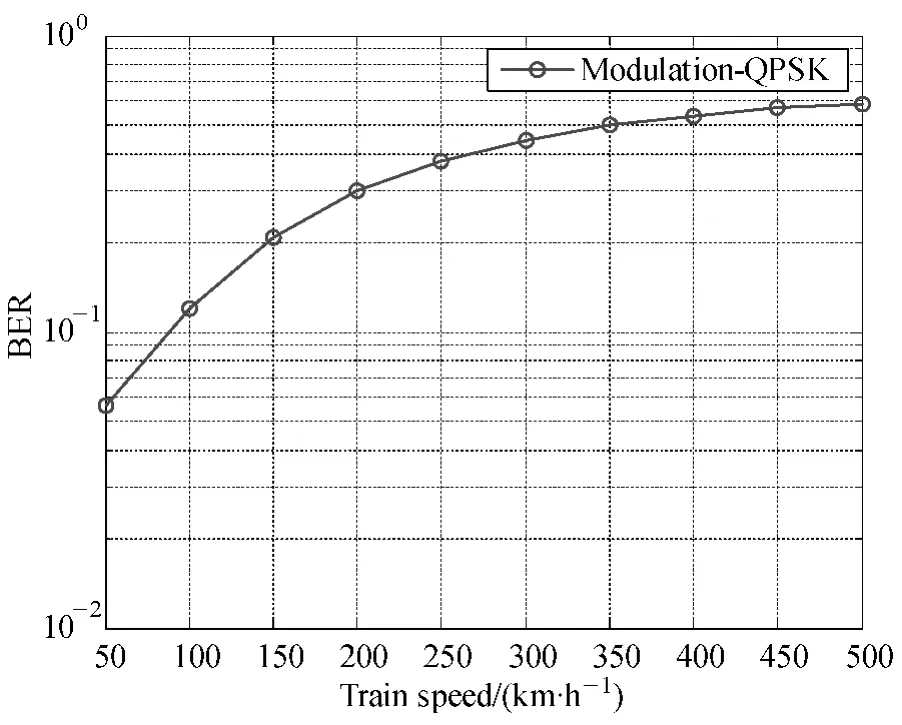
Fig.8 The change of BER performance with train speed
4 Conclusions
In this paper,by using a discrete-time non-stationary GBSM, we have analyzed the channel coefficient|Gp,q(m,k)| and CIR of one desired subcarrier and other interference subcarriers.We verify the fact that the ICI on one subcarrier mainly comes from its several neighborhood subcarriers.CIR is investigated by changing K,the multipath number L and the normalized Doppler frequency offset ε.Note that the biggest impact factor for CIR is the multipath number L and the minimum impact factor is K,and when the train speed υR>400 km/h,the normalized Doppler frequency offset ε >0.35,the CIR will tend to zero.Finally,BER is investigated by simulating a specific channel environment.Without any processing to the received signal,the BER is very high.The communication quality is very poor.Therefore,we should take some efficient measures to mitigate ICI next step.
[1]Adachi F,Kudoh E.New Direction of Broadband Wireless Technology [J].Wireless Communications and Mobile Computing,2007,7(8):969-983.
[2]3GPP.TR 25.814,Rev.7.1.0,Physical Layer Aspects for Evolved UTRA (Release 7)[S].3GPP Organizational Partners(ARIB,ATIS,CCSA,ETSI,TTA,TTC),2006.
[3]IEEE Std.802.16e-2005, IEEE Standard for Local and Metropolitan Area Networks Part 16:Air Interface for Fixed and Mobile Broadband Wireless Access Systems Amendment 2:Physical and Medium Access Control Layers for Combined Fixed and Mobile Operation in Licensed Bands and Corrigendum 1[S].New York:IEEE Computer Society and the IEEE Microwave Theory and Techniques Society,2006.
[4]Zheng J,Wang Z L.ICI Analysis for FRFT-OFDM Systems to Frequency Offset in Time-Frequency Selective Fading Channels[J].IEEE Communications Letters,2010,14(10):888-890.
[5]Wang H M,Chen X,Zhou S D,et al.Low-Complexity ICI Cancellation in Frequency Domain for OFDM Systems in Time-Varying Multipath Channels [J].IEICE Transactions on Communications,2006,89(3):1020-1023.
[6]Cai X D,Giannakis G B.Bounding Performance and Suppressing Intercarrier Interference in Wireless Mobile OFDM [J].IEEE Transactions on Communications,2003,51(12):2047-2056.
[7]Ma J,Orlik P V,Zhang J Y,et al.Reduced-Rate OFDM Transmission for Inter-subchannel Interference Self-cancellation over High-Mobility Fading Channels[J].IEEE Transactions on Wireless Communications,2012,11(6):2013-2023.
[8]Haque J,Erturk M C,Arslan H.Aeronautical ICI Analysis and Doppler Estimation[J].IEEE Communications Letters,2011,15(9):906-909.
[9]Lin K Y,Lin H P,Tseng M C.An Equivalent Channel Time Variation Mitigation Schefme for ICI Reduction in High-Mobility OFDM Systems[J].IEEE Transactions on Broadcasting,2012,58(3):472-479.
[10]Du Q,Wu G,Yu Q L,et al.ICI Mitigation by Doppler Frequency Shift Estimation and Pre-compensation in LTE-R Systems [C].Wireless Communication Systems (WCS),China,2012:469-474.
[11]Shi Q.ICI Mitigation for OFDM Using PEKF[J].IEEE Signal Processing Letters,2010,17(12):981-984.
[12]Wang H W,Lin D W,Sang T H.OFDM Signal Detection in Doubly Selective Channels with Blockwise Whitening of Residual Intercarrier Interference and Noise[J].IEEE Journal on Selected Areas in Communications,2012,30(4):684-694.
[13]Chen C Y,Lan Y Y,Chiueh T D.Turbo Receiver with ICIAware Dual-List Detection for Mobile MIMO-OFDM Systems[J].IEEE Transactions on Wireless Communications,2013,12(1):100-111.
[14]Shu F,Hlaing M,Liang Y,et al.PIC-Based Iterative SDR Detector for OFDM Systems in Doubly-Selective Fading Channels[J].IEEE Transactions on Wireless Communications,2010,9(1):86-91.
[15]Bishnu A,Jain A,Shrivastava A.A New Scheme of ICI Selfcancellation in OFDM System[C].International Conference on Communication Systems and Network Technologies,Gwalior,India,2013:120-123.
[16]Yao J,Kanhere S S,Hassan M.Mobile Broadband Performance Measured from High-Speed Regional Trains [C].Vehicular Technology Conference (VTC Fall),San Francisco,CA,USA,2011:1-5.
[17]Liu L,Tao C,Qiu J H,et al.Position-Based Modeling for Wireless Channel on High-Speed Railway under a Viaduct at 2.35 GHz[J].IEEE Journal on Selected Areas in Communications,2012,30(4):834-845.
[18]Gao L Y,Zhong Z D,Ai B,et al.Estimation of the Ricean K Factor in the High Speed Railway Scenarios[C].International Conference on Communications and Networking,Beijing,China,2010:1-5.
[19]Gesbert D,Bölcskei H,Gore D A,et al.Outdoor MIMO Wireless Channels:Models and Performance Prediction [J].IEEE Transactions on Communications,2002,50(12):1926-1934.
[20]Ghazal A,Wang C X,Haas H,et al.A Non-stationary Geometry-Based Stochastic Model for MIMO High-Speed Train Channels [ C ].International Conference on ITS Telecommunications,Taiwan,China,2012:7-11.
[21]Cheng X,Wang C X,Laurenson D I,et al.An Adaptive Geometry-Based Stochastic Model for Non-isotropic MIMO Mobile-to-Mobile Channels[J].IEEE Transactions on Wireless Communications,2009,8(9):4824-4835.
[22]Chelli A,Patzold M.A Non-stationary MIMO Vehicle-to-Vehicle Channel Model Derived from the Geometrical Street Model[C].Vehicular Technology Conference (VTC Fall),San Francisco,USA,2011:1-6.
[23]Médard M.The Effect upon Channel Capacity in Wireless Communications of Perfect and Imperfect Knowledge of the Channel[J].IEEE Transactions on Information Theory,2000,46(3):933-946.
[24]Patzold M,Hogstad B O.A Wideband MIMO Channel Model Derived from the Geometric Elliptical Scattering Model [J].Wireless Communications and Mobile Computing,2006,8(5):138-143.
[25]3GPP.TS 36.101 V10.2.1,3rd Generation Partnership Project;Technical Specification Group Radio Access Network;Evolved Universal Terrestrial Radio Access (E-UTRA);User Equipment(UE)Radio Transmission and Reception (Release 10)[S].European Telecommunications Standards Institute,2011.
[26]Jeon W G,Chang K H,Cho Y S.An Equalization Technique for Orthogonal Frequency-Division Multiplexing System in Time-Variant Multipath Channel [J].IEEE Transactions on Communications,1999,47(1):27-32.
Appendix
Derivation of Eq.(15)
Substituting the discrete channel impulse response hp,q(n,l)into Gp,q(m,k)

Because the period of one OFDM block is very short,we can find that(1 ≤l ≤L)can be approximated to constant during the OFDM period.Therefore,B(m,k),C(m,k),and D(m,k)can be described as

Because ψn1is independent and identically distributed random variable with uniform distributions over[-π,π)and the mean of ψn1is E[ψn1]= 0,= S and C(m,k)can be simplified as

In the same way,D(m,k)can be simplified as

Therefore,

Then |Gp,q(m,k)| can be achieved as

Let m=k,and B(k,k),C(k,k),and D(k,k)are as follows
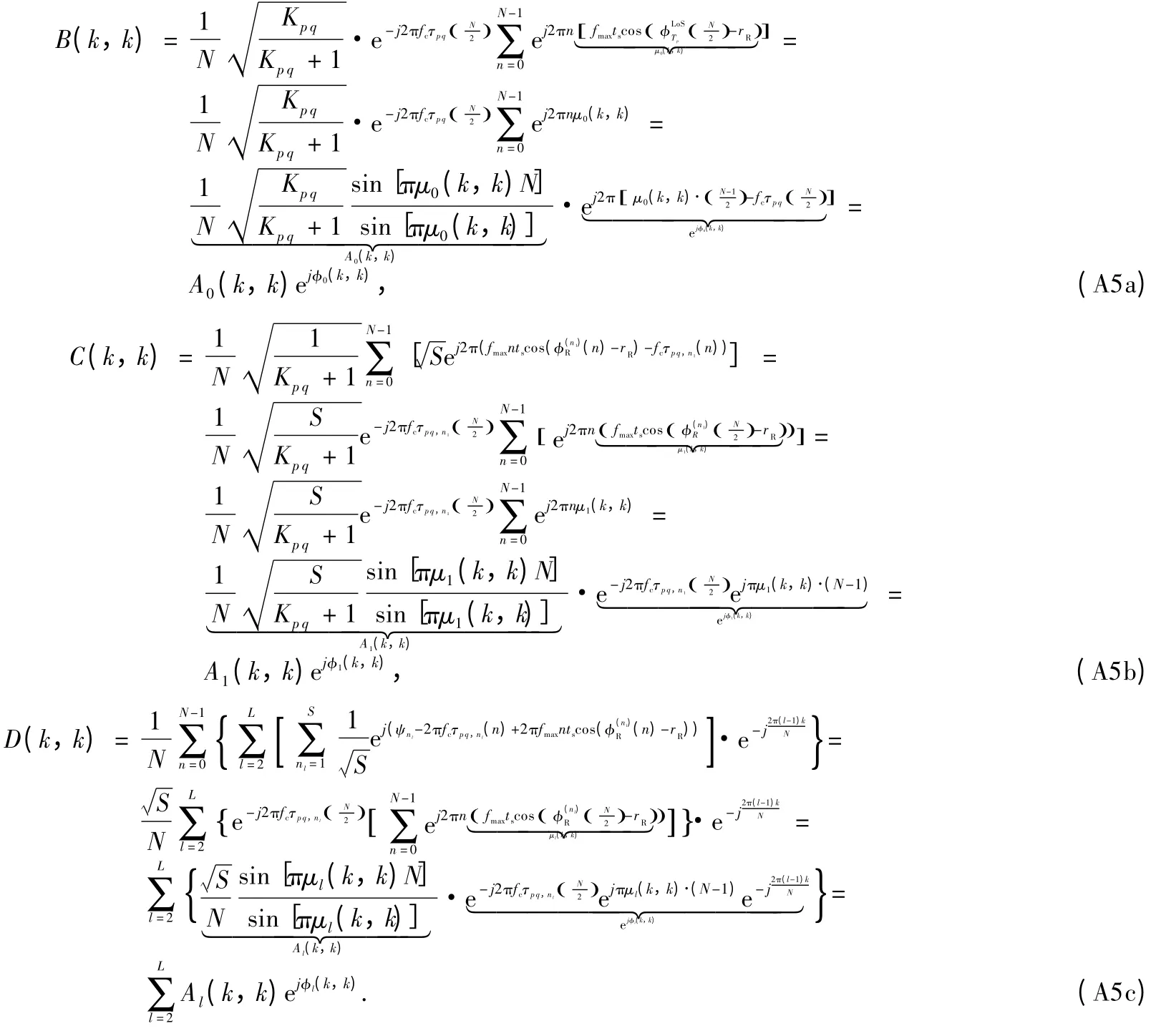
Therefore,

 Journal of Donghua University(English Edition)2015年3期
Journal of Donghua University(English Edition)2015年3期
- Journal of Donghua University(English Edition)的其它文章
- Graph Regularized Sparse Coding Method for Highly Undersampled MRI Reconstruction
- Enhanced Field Emission Performance and Better Emitting Current Stability of Mixed Multilayer Carbon Nanotube Cathode
- On Augmented Zagreb Index of Molecular Graphs
- Evaluation of Cadmium Bioavailability in Soils Using Diffusive Gradients in Thin Film Technique and Traditional Methods
- Group Performance Evaluation in Universities with Entropy Method
- Structured Query Language Injection Penetration Test Case Generation Based on Formal Description
